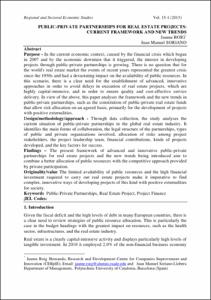Mostra el registre d'ítem simple
Public-private partnerships for real estate projects: current framework and new trends
| dc.contributor.author | Soriano Llobera, Juan Manuel |
| dc.contributor.author | Roig Hernando, Jaume |
| dc.contributor.other | Universitat Politècnica de Catalunya. Departament d'Organització d'Empreses |
| dc.date.accessioned | 2015-04-08T10:57:52Z |
| dc.date.available | 2015-04-08T10:57:52Z |
| dc.date.created | 2015-03-27 |
| dc.date.issued | 2015-03-27 |
| dc.identifier.citation | Soriano, J.M.; Roig, J. Public-private partnerships for real estate projects: current framework and new trends. "Regional and Sectoral Economic Studies", 27 Març 2015, vol. 15, núm. 1, p. 35-44. |
| dc.identifier.issn | 1578-4460 |
| dc.identifier.uri | http://hdl.handle.net/2117/27157 |
| dc.description.abstract | Purpose -In the current economic context, caused by the financial crisis which began in 2007 and by the economic downturn that it triggered, the interest in developing projects through public-private partnerships is growing. There is no question that for the world's real estate market the events of recent years represented the greatest crisis since the 1930s and had a devastatingimpact on the availability of public resources. In this scenario, there is a clear need for the establishment of advanced, innovative approaches in order to avoid delays in execution of real estate projects, which are highly capital-intensive, and in orde r to ensure quality and cost-effective service delivery. In view of the above, this paper analyses the framework and the new trends in public-private partnerships, such as the constitution of public-private real estate funds that allow risk allocation on an agreed basis, primarily for the development of projects with positive externalities. Design/methodology/approach - Through data collection, the study analyses the current situation of public-private partnerships in the global real estate industry. It identifies the main forms of collaboration, the legal structure of the partnerships, types of public and private organizations involved, allocation of risks among project stakeholders, the project leadership team, financial contributions, kinds of projects developed, and the key factors for success. Findings – The present framework of advanced and innovative public-private partnerships for real estate projects and the new trends being introduced aim to combine a better allocation of public resources with the competitive approach provided by private participation. Originality/value The limited availability of public resources and the high financial investment required to carry out real estate projects make it imperative to find complex, innovative ways of developing projects of this kind with positive externalities for society |
| dc.format.extent | 10 p. |
| dc.language.iso | eng |
| dc.rights | Attribution-NonCommercial-NoDerivs 3.0 Spain |
| dc.rights.uri | http://creativecommons.org/licenses/by-nc-nd/3.0/es/ |
| dc.subject | Àrees temàtiques de la UPC::Economia i organització d'empreses::Comptabilitat i control financer |
| dc.subject.lcsh | Real state management |
| dc.subject.other | Public-Private Partnerships |
| dc.subject.other | Real Estate Project |
| dc.subject.other | Project Finance |
| dc.title | Public-private partnerships for real estate projects: current framework and new trends |
| dc.type | Article |
| dc.subject.lemac | Béns immobles--Administració |
| dc.contributor.group | Universitat Politècnica de Catalunya. OPE - Organització de la Producció i d'Empresa (aspectes tècnics, jurídics i econòmics en Producció) |
| dc.description.peerreviewed | Peer Reviewed |
| dc.rights.access | Open Access |
| local.identifier.drac | 15554385 |
| dc.description.version | Postprint (published version) |
| local.citation.author | Soriano, J.M.; Roig, J. |
| local.citation.publicationName | Regional and Sectoral Economic Studies |
| local.citation.volume | 15 |
| local.citation.number | 1 |
| local.citation.startingPage | 35 |
| local.citation.endingPage | 44 |
Fitxers d'aquest items
Aquest ítem apareix a les col·leccions següents
-
Articles de revista [841]
-
Articles de revista [62]


